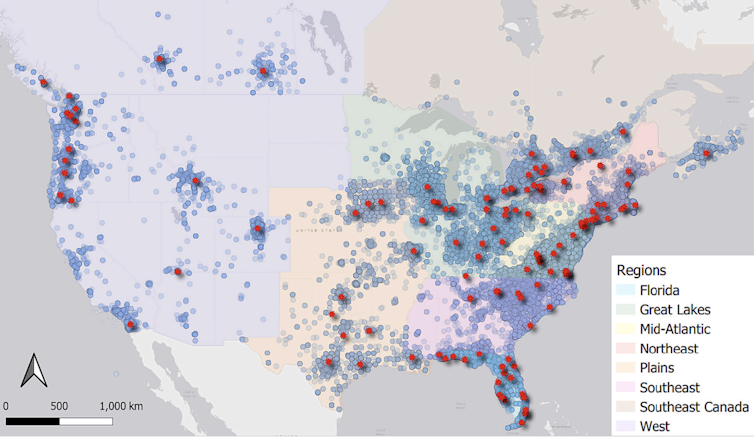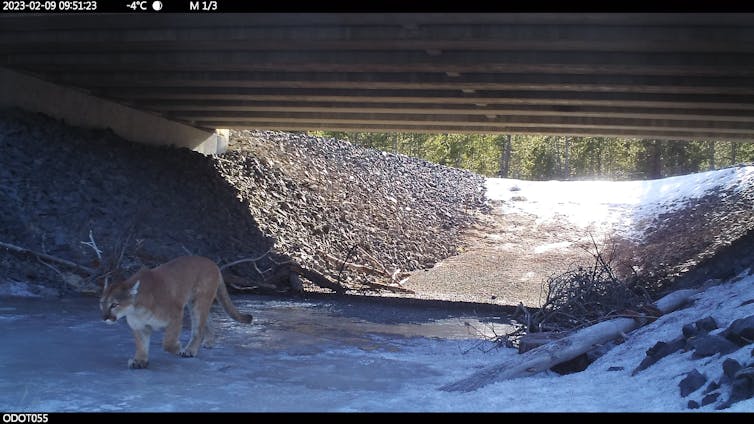Digitized records from wildlife centers show the most common ways that humans harm wild animals
Hundreds of wildlife rehabilitation centers across the US and Canada treat sick and injured animals and birds. Digitizing their records is yielding valuable data on human-wildlife encounters.
At hundreds of wildlife rehabilitation centers across the U.S., people can learn about wild animals and birds at close range. These sites, which may be run by nonprofits or universities, often feature engaging exhibits, including “ambassador” animals that can’t be released – an owl with a damaged wing, for example, or a fox that was found as a kit and became accustomed to being fed by humans.
What’s less visible are the patients – sick and injured wild animals that have been admitted for treatment.
Each year, people bring hundreds of thousands of sick and injured wild animals to wildlife rehab centers. Someone may find an injured squirrel on the side of the road or notice a robin in their backyard that can’t fly, and then call the center to pick up an animal in distress.
We study ecology and biology, and recently used newly digitized records from wildlife rehabilitation centers to identify the human activities that are most harmful to wildlife. In the largest study of its kind, we reviewed 674,320 records, mostly from 2011 to 2019, from 94 centers to paint a comprehensive picture of threats affecting over 1,000 species across much of the U.S. and Canada.
Our findings, published in the journal Biological Conservation, point to some strategies for reducing harm to wildlife, especially injuries caused by cars.
Tracking the toll
Humans are responsible for the deaths and injuries of billions of animals every year. Bats and birds fly into buildings, power lines and wind turbines. Domestic cats and dogs kill backyard birds and animals. Development, farming and industry alter or destroy wild animals’ habitats and expose wildlife to toxic substances like lead and pesticides. Extreme weather events linked to climate change, such as flooding and wildfires, can be devastating for wildlife.
Most Americans support protecting threatened and endangered species, and recognize that human activities can harm wildlife. But it is surprisingly difficult to determine which activities are most harmful to wildlife and identify effective solutions.
Information from wildlife rehab centers across the U.S. can help fill in that picture. When an animal is brought into one of these centers, a rehabilitator assesses its condition, documents the cause of injury or illness if it can be determined, and then prepares a treatment plan.
Wildlife rehabbers may be veterinarians, veterinary technicians or other staff or volunteers who are certified by state agencies to treat wildlife. They follow professional codes and standards, and sometimes publish research in peer-reviewed journals.
A growing data pool
Until recently, most wildlife rehab records existed only in binders and file cabinets. As a result, studies drawing on these records typically used materials from a single location or focused on a particular species, such as bald eagles or foxes.
Recently, though, rehab centers have digitized hundreds of thousands of case records. Shareable digital records can improve wildlife conservation and public health.
For example, the Wildlife Center of Virginia has worked with government agencies and other rehab centers to establish the WILD-ONe database as a tool for assessing trends in wildlife health. This will be an exciting area of research as more records are digitized and shared.

Threats vary by species
Using this trove of data, we have been exploring patterns of wildlife health across North America. In our study, we identified key threats affecting wildlife by region and for iconic and endangered species.
Overall, 12% of the animals brought to rehab centers during this period were harmed by vehicle collisions – the single largest cause of injury. For great horned owls, which are common across the U.S., cars were the most common cause of admission – possibly because the owls commonly forage at the same height as vehicles, and may feed on road kill.
Other threats reflect various animals’ habitats and life patterns. Window collisions were the most common injury for the big brown bat, another species found in many habitats across the U.S. Fishing incidents were the main reason for admission of endangered Kemp’s ridley sea turtles, which are found in the Gulf of Mexico and along the Atlantic coast.
Toxic substances and infectious diseases represented just 3.4% of cases, but were important for some species. Bald eagles, for example, were the species most commonly brought to centers with lead poisoning. Eagles and other raptors consume lead ammunition inadvertently when they feed on carcasses left in the wild by hunters.
In southern Florida, hurricanes and floods resulted in spikes in the numbers of animals brought to rehab centers, reflecting the impact of climate-driven extreme weather events on wildlife health.
About one-third of animals in the cases we reviewed were successfully released back to the wild, though this varied greatly among species. For example, 68% of brown pelicans were released, but only 20% of bald eagles. Unfortunately, some 60% of the animals died from their injuries or illnesses, or had to be humanely euthanized because they were unable to recover.
Spotlighting solutions
Our results spotlight steps that can help conserve wildlife in the face of these threats. For example, transportation departments can build more road crossings for wildlife, such as bridges and underpasses, to help animals avoid being hit by cars.

Wildlife management agencies can ban or limit use of ammunition and fishing gear that contain lead to reduce lead poisoning. And governments can incorporate wildlife into disaster management plans to account for surges in wildlife rescues after extreme weather events.
People can also make changes on their own. They can drive more slowly and pay closer attention to wildlife crossing roads, switch their fishing and hunting gear to nonlead alternatives, and put decals or other visual indicators on windows to reduce bat and bird collisions with the glass.
To learn more about animals in your area and ways to protect them, you can visit or call your local wildlife rehab center. You can also donate to these centers, which we believe do great work, and are often underfunded.
The scale of threats facing wild animals can seem overwhelming, but wildlife rehabbers show that helping one injured animal at a time can identify ways to save many more animal lives.
Tara K. Miller received funding from the National Science Foundation.
Richard B. Primack does not work for, consult, own shares in or receive funding from any company or organization that would benefit from this article, and has disclosed no relevant affiliations beyond their academic appointment.
Read These Next
From truce in the trenches to cocktails at the consulate: How Christmas diplomacy seeks to exploit s
World leaders like to talk up peace at Christmastime. But alongside the tales of seasonal breaks in…
As DOJ begins to release Epstein files, his many victims deserve more attention than the powerful me
Powerful men connected to Jeffrey Epstein are named, dissected and speculated about. The survivors,…
How to reduce gift-giving stress with your kids – a child psychologist’s tips for making magic and a
Depending on family circumstances and a child’s personality type, gift giving runs the gamut of fun…






